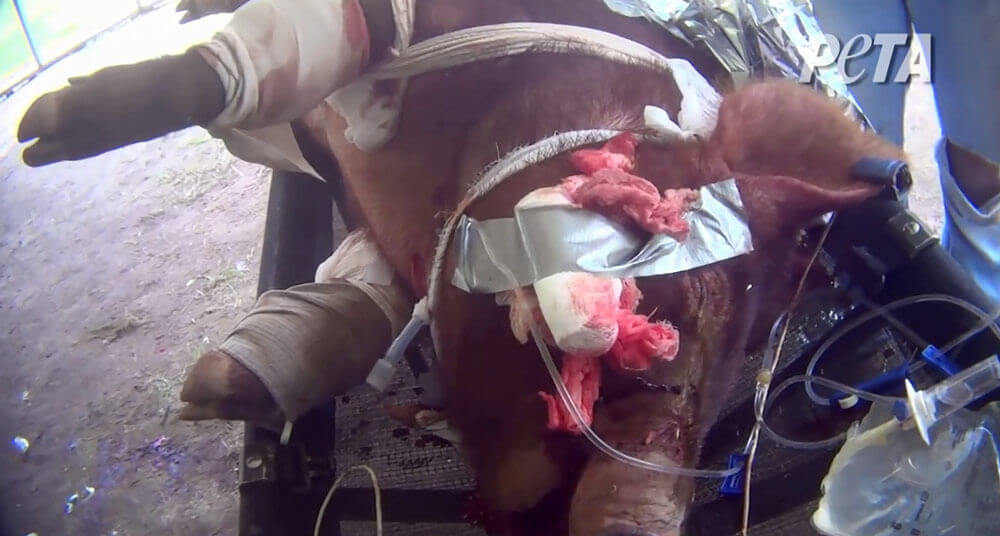Dolphins, Bees, Goats, and Others: Animals You Didn’t Know Suffer in War
The bloodshed and horror of war don’t just affect humans. Many militaries have exploited other animals and forced them to participate and often die in battles, defensive moves, and heartless trauma training. This Memorial Day, as we honor the memory of U.S. troops who have lost their lives, let’s also remember the animals who have been forced into military service. PETA explains why animals are not soldiers or weapons and what you can do to help end the deadly use of animals in war.
Dolphins and Other Marine Animals Exploited for Warfare
Russian President Vladimir Putin’s war effort in Ukraine seems to be using “war dolphins” at an important harbor in the Black Sea that houses several Russian warships. According to a naval analyst, satellite images suggest that Russia filled two pens with dolphins at the Crimean harbor in February—timing that lines up with the Russian invasion of Ukraine. It’s suspected that the dolphins are trained to deter divers or warn humans if there is a threat to the warships.
PETA Vice President of International Laboratory Methods Shalin Gala explained to USA Today why using dolphins as naval security is so abusive:
Russia’s apparent installation of two pens filled with dolphins at a Crimean harbor puts these sensitive and loving animals in grave danger and fails to deter would-be saboteurs of its warships effectively.”
Russian forces are not alone in exploiting intelligent sea animals. The U.S. Navy also forces dolphins to participate in its war efforts. Dolphins, sea lions, and beluga whales have been trained to track down mines, warn off enemy divers, communicate if there has been a breach, and perhaps even engage in defensive combat. This behavior does not come naturally to them, and being forced to perform these operations comes at the cost of their freedom.
Exploiting animals like dolphins for warfare not only puts their physical well-being at risk but also denies them all elements of their natural lifestyle. When free in the sea, dolphins live in large, complex social groups and swim vast distances every day in the open ocean. When exploited in captivity, they can only swim in endless circles inside pens that, to them, are the equivalent of bathtubs.
Other Animals Who Are Used in Wars Around the World
Despite modern technology with capabilities that far exceed those of animals, today’s militaries continue to exploit them in warfare. Horses, dogs, bees, and other animals are often forced into dangerous situations that a human soldier would never have to face—like sniffing out bombs or even being blown up as a living bomb. These uses of animals in warfare are examples of speciesism, the misguided belief that certain animals are worth more than others and that other animals’ needs and desires are less important than those of humans. Animals used around the world in war include the following:
- Dogs forced to participate in warfare, euphemistically called “military dogs,” are trained to use their keen sense of smell to locate landmines—a dangerous job that has caused many animal deaths. Dogs are also kept as companions to troops but are sometimes left behind during emergency evacuations.
- Rats are also used to sniff out mines and are considered more cost-effective than dogs, as they are less expensive to raise and deemed easier to replace.
- Bees, too, are used to search for explosives. Entire hives—consisting of tens of thousands of bees—are trained to associate the smell of explosives with food. Where the animals swarm, there is likely a mine.
- Horses, mules, and camels are still used for military transportation on narrow roads and hazardous treks, even though motorized vehicles such as tanks, cars, and off-road carts are much more effective.
- Goats and pigs are mutilated and killed in barbaric medical training. A brave whistleblower recorded horrific video footage of a trauma training drill held by the U.S. military during which goats’ legs were severed and their internal organs were cut out of their abdomens. PETA also uncovered similar abuse of pigs during its eyewitness investigation into Deployment Medicine International, which, at the time, was the self-proclaimed “single largest trainer of U.S. military forces in operational medicine.” Equally barbaric trauma training occurs in other militaries as well.
Today, high-tech humanlike simulators—available specifically for military training—can breathe, bleed, cry, talk, and respond to medications. Training with equipment that accurately mimics human anatomy, physiology, and behavior is obviously more humane and effective than cutting apart, blowing up, shooting, and killing thousands of animals every year.
Urge the U.S. Department of Defense to Stop Mangling Animals
PETA has persuaded the U.S. Coast Guard to end its use of animals in cruel trauma training drills, swayed the U.S. Army to use simulators instead of monkeys in chemical-attack training exercises, and moved the U.S. Department of Defense (DOD) to stop forcing hard plastic tubes down cats’ and ferrets’ windpipes during pediatric intubation training.
Although former President Donald Trump signed into law a bipartisan bill that included a PETA-backed provision that made human-simulation technology the new gold standard of trauma training, there’s still more work to be done. We’re urging the DOD to stop dragging its feet and permanently end the use of animals in trauma training drills—which more than 70% of NATO nations have already done. Join us by taking action below!


